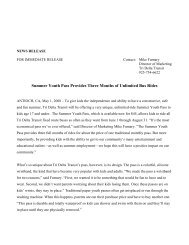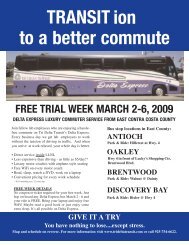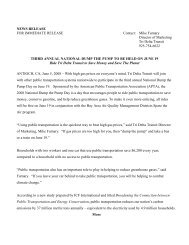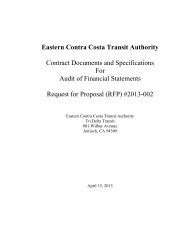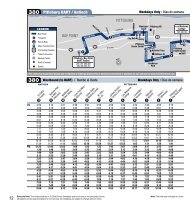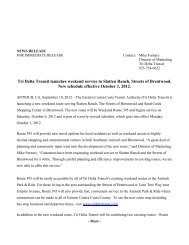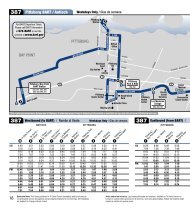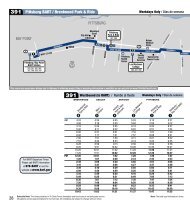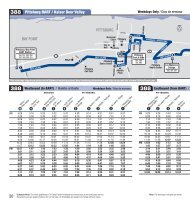to view Short Range Transit Plan FY 2007/2008 - Tri Delta Transit
to view Short Range Transit Plan FY 2007/2008 - Tri Delta Transit
to view Short Range Transit Plan FY 2007/2008 - Tri Delta Transit
Create successful ePaper yourself
Turn your PDF publications into a flip-book with our unique Google optimized e-Paper software.
Off-Street Bus ways with Level CrossingsThe Eugene-Springfield EmX and Las Vegas MAX BRT projects operatein a combination of mixed flow traffic and separate bus lanes within anexisting arterial street. This section discusses two BRT systems thattake a different approach, with ground-level bus ways on off-streetrights-of-way with level grade crossings similar <strong>to</strong> most light rail transit(LRT) systems.San Fernando Valley Orange Line Bus wayThe 14-mile, $300 million+ Orange Line bus way in Los Angeles’s SanFernando Valley opened on Oc<strong>to</strong>ber 90, 2005. The Orange Line isoperated by the Los Angeles Metropolitan Transportation Authority(MTA), operating every 3-5 minutes during peak periods, and every10-15 minutes at other times.This route reached its projected Year 2030 patronage of approximately24,000 daily boardings by April <strong>2007</strong>, and now operates at itsmaximum feasible capacity. Bus way capacity is essentially limited bythe large number of signalized level crossings with major north-southarterials severely limits the bus way’s capacity; the maximumfrequency that ensures reliable service without bus “bunching” hasproven <strong>to</strong> be every 3 minutes, i.e., twice the typical traffic signal cycleat each intersection. While more frequent service is technically possibleon the Orange Line Bus way, buses operating less than every 3minutes on any given route tend <strong>to</strong> experience delays at signals. Busheadways are no longer evenly spaced and buses often “bunch,”leading <strong>to</strong> increasingly uneven frequencies that degrade servicequality.The many mixed traffic Metro Rapid routes operated by the LosAngeles Metropolitan <strong>Transit</strong> Authority (MTA) in the Los Angeles Basinhave also experienced this frequency limitation phenomenon. The largenumber of bus way crossings also limits the bus way’s operatingspeeds. Original plans projected 28-minutes travel time over thelength of the bus way, but in practice running times are usually 40-45minutes. After a spate of accidents, crossing speeds were reduced <strong>to</strong>10 m.p.h. See Figure 4.13 for a typical Orange Line crossing of a majorarterial.Figure 4.11 Orange Line Bus way Route70




